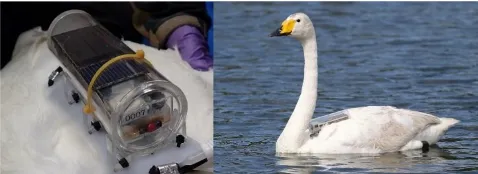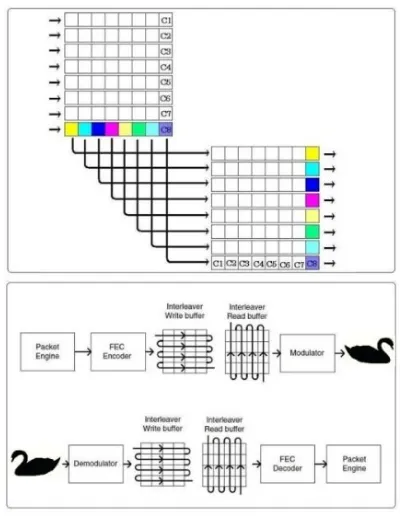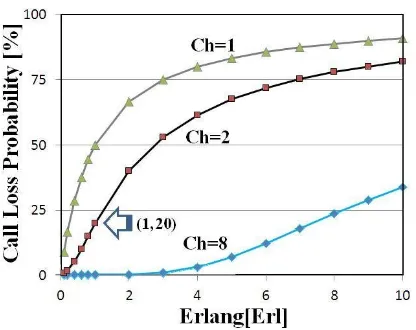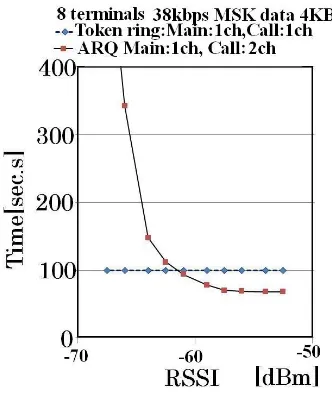http://dx.doi.org/10.9717/JMIS.2018.5.3.163
163
I. OBJECT
We developed a multicast communication packet radio protocol using a time-sharing tablet system (“wireless token ring”) for the efficient exchange of files among packet radio terminals attached to swans (Figure 1). This report gives a summary description of the system.
Figure 1. Developed packet terminal for bird to bird communications.
II. BACKGROUND
2.1. Frequency resources
Station licensing has already been obtained for 13 sub-stations using the industry, science, and medical (ISM) 2.4 GHz band. However, if we assume that frequencies will be
allocated in the near future from the ITU-R specifically for use with birds, the frequencies (number of channels) available will be more limited. The key behind this system lies in how efficient communication among a large number of terminals at hotspots, such as feeding grounds, is ensured with limited frequencies.
2.2. Full automation
Human intervention is not possible in the environments in which this system is to be used. Thus, the system requires a special protocol that enables individual terminals to automatically transfer files containing vital data and share respective vital data with other terminals. More specifically, the required protocol must enable all files to be shared by all terminals by creating and managing file lists, removing already registered duplicate files of other terminals from files acquired via multicast communication, and requesting files not registered from other terminals. These requirements clearly differ from those for the Internet of Things, for which an Internet connection is a prerequisite.
2.3. Synchronization
Communication is established once the following two time axes are synchronized:
2.3.1. Macro synchronization
Communications Protocol Used in the Wireless Token Rings
for Bird-to-Bird
Isao Nakajima
1,*, Hiroshi Juzoji
2, Kiyoaki Ozaki
3, Noboru Nakamura
3Abstract
We developed a multicast communication packet radio protocol using a time-sharing tablet system (“wireless token ring”) to achieve the efficient exchange of files among packet radio terminals attached to swans. This paper provides an overview of the system and the protocol of the packet communications. The packet device forming the main part of the transceiver developed is the Texas Instruments CC2500. This device consists of one call-up channel and one data transmission channel and could improve error frame correction using FEC (forward error correction) with 34.8 kbps MSK and receiving power of at least -64 dBm (output 1 dBm at distance of 200 m using 3 dBi antenna). A time-sharing framework was determined for the wireless token ring using call sign ordinals to prevent transmission right loss. Tests using eight stations showed that resend requests with the ARQ (automatic repeat request) system are more frequent for a receiving power supply of -62 dBm or less. A wireless token ring system with fixed transmission times is more effective. This communication protocol is useful in cases in which frequency resources are limited; the energy consumed is not dependent on the transmission environment (preset transmission times); multiple terminals are concentrated in a small area; and information (position data and vital data) is shared among terminals under circumstances in which direct communication between a terminal and the center is not possible. The method allows epidemiological predictions of avian influenza infection routes based on vital data and relationships among individual birds based on the network topology recorded by individual terminals. This communication protocol is also expected to have applications in the formation of multiple in vivo
micromachines or terminals that are inserted into living organisms.
Key Words: Multicast, Tablet, Vital data, Avian influenza
Manuscript received September 7, 2018; Revised September 22, 2018; Accepted September 26, 2018. (ID No. JMIS-2018-0043) Corresponding Author (*): Isao Nakajima, Shimokasuya143, Isehara City, Japan. +81463913130, E-mail: js2hb@ets8.jp. 1Tokai University, Isehara City, Japan. E-mail: js2hb@ets8.jp
2EFL Inc., Takaoka City, Japan. E-mail: juzoji@yahoo.co.jp
164 This involves determining the time at which
communication starts. In the case of bird-to-bird communication with swans, for reasons related to power from solar battery, communication starts at 0 minutes 0 seconds every two hours during local daylight hours. 2.3.2. Micro synchronization
The clock component is extracted from the signal received and encoding is requested. The received clock is regenerated inside the CC2500 receiver device.
2.4. Communication environment
The plains and tundra of Russia and Mongolia, where swans migrate to nest during the summer months, are desolate and lack wireless repeaters for mobile phones. Satellite communication is not feasible because free-space propagation losses are far more significant compared to terrestrial signals when sending large data volumes. We examined storage transfer-type wireless communication systems as a potential approach given these adverse conditions. From field studies, we know that the birds move in families or groups within small areas established within the breeding grounds by waterways flowing into the wetlands that represent the feeding grounds. Determining
macro synchronization will establish wireless
communication.
2.5. Packet radio communication
Packet radio communication is a wireless
communication system in which data is transmitted and received in small packets. The data packets are transmitted along with additional data such as recipient address, data frame number, and CRC. Based on CCIRR X.25, this system has been used in amateur radio communications since the 1980s with the AX.25 protocol. We have been involved in developing a wearable terminal that relies on packet radio communication to send electrocardiogram data for a test subject running outdoors to an ETS-VIII satellite situated in geostationary orbit. This approach differs from mobile phone communication in that terminals can communicate with each other directly, without the need for repeaters, and can bring back data collected from other terminals [1,2,3]. In short, a single swan returning to Hokkaido would on its own bring back vital data for all other swans living alongside at a lake in the Russian tundra.
2.6. Living creature information network
Fitting packet communication terminals to the backs of swans allows us to calculate relative distances using GPS positional information or equations using free-space propagation losses and relative receiving power [4,5,6,7]. Sharing this information provides information on the network topology, of which the biological analogy is the formation of flocks.
The term metaheuristics refers to the independence of specific calculation problems in algorithms for combination optimization problems. These solutions are sometimes based on biological solutions. Past examples include the traveling salesman problem to optimize (minimize) travel distances versus the ant colony optimization [8].
In the case of birds, Xin-She Yang states “The routes
taken by cuckoos when looking for the nests of other birds in which to deposit their eggs follow a Levy distribution.
This method could also be used as an algorithm for optimizing other techniques [8,9]. ” Sarker also points out that autonomous control systems in insects and other animal communities can be used in AI and optimization for next-generation communal tasks involving multiple robots[10,11]. According to birdwatchers, swans live in small family groups, which in turn combine to form larger formations. Analyzing the network topology by fitting terminals to the backs of swans would verify whether or not this is correct. If the network really is formed of family groups, the topology algorithm for swans could closely resemble the optimization algorithm for the flight of fireflies reported by Xin-She Yang.
III.
METHOD
3.1. Proposed communications protocol and network topology
Token rings were used in the IEEE 802.5 LAN protocol proposed by IBM before the spread of the Internet [12]. This protocol suffers from the phenomenon that communication over the entire network will come to a halt if a tablet (transmission right) disappears for some reason. For this reason, it has not been used in wireless communications, where there is a high risk of tablet disappearance.
We devised a method to prevent tablet disappearance by setting virtual tablets in advance to a time schedule. In practice, each terminal acquires the accurate clock from a GPS receiver; this is used to achieve macro synchronization. As shown in Fig. 2 and Fig. 3, tablets are moved in sequence by time, allowing more terminals to participate in a network in sequence on the same frequency. Each terminal receives the respective signals and assesses the receiving power for individual stations in parallel, making it possible to record the distances from other stations on a list based on the free-space propagation loss formula. Sharing this list enables the diagram to be plotted in virtual space. This network topology is obtainable without using GPS positional information.
Figure 2. Token ring schematic diagram.
http://dx.doi.org/10.9717/JMIS.2018.5.3.163
165 3.2. Forward Error Correction (FEC)
FEC is a standard convolution method and uses interleaving (Figure 4) to disperse burst noise with K = 7 and an efficiency of 1/2. Data rows are arranged horizontally including CRC and read out vertically. On the receiving side, they are arranged horizontally and read out vertically, enabling burst errors which tend to be localized to be dispersed.
Figure 4. FEC schematic diagram (CC2500).
3.3. Communication behavior and creating vital data files
Tables 1, 2,and 3 summarize the communications protocol, transmission behavior and file creation procedures for the terminal (TI CC2500).
Table 1. Communications protocol
Call channel(OOK )
0. Check timing window for transmission
1. Career sense, check received power as noise level
2. Transmission “ON” when both the item 0th and the item 1st are materialized.
3. Transmit “”ID and GPS navigation data” by (2m+1) time 4. Reception “Error compensation between packet frames with majority rule”
5. Transmission “ON” when both the item 0th and the item 1st are materialized.
6. Transmit “List of received ID and location data” by (2m+1) time
7. Reception “Error compensation between packet frames with majority rule”
8. Count all participating terminals.
9. Check the same number k of timing for the transmitting window.
10. Grasp “network topology” from the navigation data of each terminal.
11. Calculate the lower level terminal with free-space-propagation loss (grasp hiding terminals)
12. Move to main channel
Main channel(MSK)
13. Transmission “ON” when both the item 0th and the item 1st are materialized.
14. Transmit “Vital data” by (2m+1) time
15. Reception “Error compensation between packet frames with majority rule”
16. Transmission “ON” when both the item 0th and the item 1st are materialized.
17. Transmit “List of data reception” by(2m+1) time 18. The end of communications
Table 2. Transmission mode behavior
Transmission mode behavior
1. Wait until preset time 2. CC2500 initialization 3. Frequency setting 4. Modulation system setting 5. Error correction setting 6. Data speed setting
7. Transmission output setting 8. Clear transmission FIFO 9. Packet length setting
10. Write data to transmission FIFO
11. Free transmission frequency confirmation 12. Packet transmission
13. Repeat from Step 8 until data end. 14. Switch to receiving mode
Table 3. Creating vital data files
vital data files
Illuminance data (5 times per second) recorded for 20 seconds Angular velocity meter pitch axis (20 times per second) FFT peak recorded for 50 seconds (amplitude, frequency)
2 Hz to 5 Hz IFFT waveform record as above
Angular velocity meter pitch axis (10 times per second) FFT peak recorded for 100 seconds (amplitude, frequency) Under 2 Hz IFFT waveform record as above
Angular velocity meter pitch axis (1,000 times per second) FFT recorded for 1 second
Angular velocity 3-axes + wing beat detection pitch sensor (200 times per second) recorded for 9 seconds
This data is written to a 4 KB (fixed format, fixed length) daily report.
3.4. Simulation
We used simulations to validate prerequisites for comparing the token ring system against the ARQ communication system. Here, if the communication volume is x (units: erlang) and the number of lines is n, the call loss B (n, x) will be given by the following:
166
Figure 5. Correlation between call loss probability, number of channels, and erlang.
Large maximum collection capacities are possible for multicast communication using the token ring system. With the CC2500, accounting for processing times for both the CPU and CC2500, around 40 stations are estimated for 60 seconds per cycle, including 4 kB file control, and around 13 stations are estimated for 20 seconds per cycle.
However, if we assume sufficiently high rotation gains and no resend requests, we can calculate the time required for one-to-one communication with a main channel for one file as follows:
Time required for one-to-one communication = T1 * n(n - 1)/2.
If we assume that the call channel call loss probability varies under conditions in which the signal strength is sufficient and no resend requests arise, the two previous equations can be added together.
3.5. Testing with hardware
Since it is not possible to carry out tests that manipulate the CC2500 parameters in a real packet communication terminal, we built nine prototype boards to control the same CC2500 using an LPC1768 ARM CPU. As shown in Figure 6, the terminals are located at four points forming a regular triangular pyramid, with the ninth being a dedicated receiving terminal connected to a PC via a serial port to monitor communication. We used a received signal strength indicator (RSSI) to evaluate receiving power and obtained the time required by measuring start and finish at the ninth monitoring terminal. Table 3 gives the test conditions.
3.6. Test results
Figure 7 shows the results obtained from testing using the conditions described previously. With FEC(–) encoding, CRC detection errors occur at a rate of roughly 10%, even under communication conditions characterized by sufficient gain, with receiving power between -64 dBm and -55 dBm. This corresponds to a communication distance between 200 m and 66 m, or close to 90% of the area serviced. This capability likely corresponds to the price of the commercially-available CC2500 IC, but we see that all errors are corrected if set to FEC(+). That is, FEC(+) is an essential condition if we use the CC2500 for a token ring
system as the basis of multicast communication.
Table 4. Test conditions.
Condition of CC2500
ARQ one-to-one communication and token ring communication were implemented, respectively, with packet radio communication and eight terminals.
2 call channels for the ARQ system, 2,400 bps for call channel Conditions: File size: 4 kB per file; frequency: 2,450 Hz; transmission rate: 2,400 bps for call channel and 38 kbps for main channel; MSK, FEC(+)
Call volume: With 0.125 second channel occupancy time for one second per station, the communication volume for eight stations is 1 [Erlang].
Figure 6. Terminal layout and token ring time schedule used in testing.
Figure 7. Error frame correction using FEC.
http://dx.doi.org/10.9717/JMIS.2018.5.3.163
167 This is a clearly inferior communication system for terminals characterized by limited power supply. It should be noted that the error rate was close to zero for both systems above -64 dBm, with little difference between the two systems.
Figure 8. Comparison of time required.
IV.
PROPOSALS
4.1. Tokens
With cable-based token ring systems specified by IEEE 802.5, the network cannot be restored if one terminal fails, after which packets cannot be received normally or cleared[12,13,14]. Similar conditions arise if a token disappears during transmission. To handle situations like this, monitoring rights are assigned to special terminals, and functions are implemented to reissue a token if the token is not circulated for a preset period of time. Another function bypasses defective nodes by connecting the ring input and ring output directly to isolate a failed node.
Wireless communications are susceptible to congestion, and it has traditionally been considered extremely difficult to implement a token ring system using tablets, as in cable-based systems. In this study, we adopted a system to assign numbers to certain call signs, group them by divisors, and assign tokens using a time-sharing method. We implemented this system for packet radio communication and demonstrated its effectiveness in validation testing. We believe a communication protocol like this is applicable to situations involving multiple terminals or micromachines inserted into living organisms when direct communication between a terminal and the center is not possible.
4.2. Usefulness in understanding topology
Understanding the network topology is essential to determining the transmission of infectious diseases. Individuals do not become infected unless they come into close proximity to another infected individual. Individuals in contact with numerous other individuals within a flock— in other words, individuals at the center of a flock—are
more likely to become infected. In human societies, commuters traveling in crowded trains are more likely to contract influenza than a hermit living in the mountains. With flocks of birds, individuals that become infected and weaken move away from the center of the flock and are driven to the periphery. The ability to determine the position of infected individuals within the flock based on communication network science would corroborate the field observations of birdwatchers. The following terms are important in an analysis of network topology[18-20].
4.2.1. Degree centrality
Degree centrality is defined as the total score for the neighboring terminals of one terminal if a score of 1 is assigned to terminals that allow both incoming and outgoing communication and a score of 0 is assigned to receive-only or transmit-only terminals. This value makes it possible to determine that a terminal surrounded by a large number of other terminals is at the center of a group, without needing to consider the configuration of an organizational network. In studies of infectious diseases, individuals in the center are assumed to be at greater risk of infection.
4.2.2. Closeness
If the transmission output and antenna gain are identical, the distance r to different terminals can be determined from the terminal receiving power and free-space propagation loss equation. The spatial topological correlation for each can be numerically evaluated using the distance r. Since the respective receiving power and distance r values are known, this value can be used to calculate the shortest distance to implement a gateway for file transfer routes. (The method is described in “4.3 Applying shortest route.”) Additionally, removing terminals for which the closeness exceeds a threshold value from the network initially may identify hidden terminals and reduce the load on the overall network.
4.2.3. Betweenness
This expresses as a score how frequently a terminal (station) serves as a gateway. Stations with high scores feature more packet collisions and wasted congestion. Setting alternative bypass routes can be considered for terminals that exceed a threshold for file transfer using one-to-one communication.
4.2.4. Eigenvector
Individual terminal centrality scores are calculated in proportional to the centrality of the neighboring terminals. This indicates closeness to terminals with high centrality; if we regard terminals with high centrality as alpha males within a flock, information is easier to acquire in relation to other individuals. Migratory birds with high eigenvectors returning to Japan can be assumed to bring back large numbers of files for the entire flock, even if they are not alpha males.
168 We developed a system for packet communication
between terminals attached to swans using token rings and FEC. We verified that this system offers the following communication features:
1. All terminals use the same frequency for efficient frequency utilization.
2. Low energy consumption (completed within preset communication time)
3. Suitability for environments in which multiple terminals are concentrated within a small space
4. Allows information sharing among terminals that are not capable of communicating directly to the center.
5. The network topology recorded by individual terminals is expected to shed light on the relationships between individuals within a flock and to provide vital data for epidemiological predictions of avian influenza infection routes.
Acknowledgements
This study was funded by research grants from the Ministry of Education, Culture, Sports, Science and Technology (21241042, 23651169, 24241058, 26630165, and 15H01791).
We wish to express our gratitude to Prof. Toshihiko Kitano, Tasada Works of Takaoka City, Japan System Design Inc. of Hiroshima City for help with verification testing and C language programming.
REFERENCES
[1] I. Nakajima, T. Kitano, M. Katayama, L. Androuchko, “Expected Communications Technology to Track Avian Influenza and Related the Statement of Appeal by ITU-D SG2 Q14”, Int. J. eHealth & Medical Communications vol.2, no.4, pp.20-37, 2010.
[2] I. Nakajima, “Telecommunications for Disaster and
Pandemics”
www.ituaj.jp/wp-content/uploads/2013/04/nb25-2_web-10_tokai.pdf [3] Kitano T, Nakada K, Kinoue T, et al. Development of
Ultra-Compact Bird-Borne S-Band Transceiver for Wild Birds”, Proceedings of the 20th Symposium of the
International Society on Biotelemetry
(ISOB2014),pp.70-77, 2014, Kyoto.
[4] ITU-D RGQ 14-2/2/069-E, Liaison Statement on the role of telecommunication/ICT top be used for an integrated ICT network to monitor the avian influenza. [5] ITU-D RGQ 14-2/2/070-E, Note to the Director of BDT,
Proposal for an integrated ICT network to monitor the avian influenza.
[6] Working Parties 7B and 7C, Doc 7B/TEMP/38-7 C/TEMP/22, ITU-D RGQ 14-2/2/071-E, Liaison Statement, Reply to a liaison statement from ITU-D Study group 2 regarding an ITU-D Study Group 2 Question.
[7] ITU-D RGQ 14-2/2/079-E, Avian Influenza and expected telecommunication technical development. [8] “Basic Description of the Argos System”, Feb. 2018;
www.webpages.uidaho.edu/wlf314/labs/Argos System Description.pdf.
[9] North Star, ”Tracking Birds”,
www.northstarst.com/tracking-birds, Mar. 2018. [10] O. Roy, J. Hart, “Transmitter for Telemetry of
Biological Data from Birds in Flight”, IEEE Transactions on Bio-medical Electronics, vol.10, no.3, pp.114-116, July 1963.
[11] E. Morishita, K. Itao, K. Sasaki, H. Higuchi,"Movements of Crows in Urban Areas Based
on PHS Tracking";
www.airies.or.jp/attach.php/.../save/0/0/07_2-09.pdf, Feb. 2018.
[12] Y. Li, Y. Yin, "Bird Objects Detection and Tracking on the Wild Field Circumstance", Proceedings of EEE Computer Society WRI World Congress on Computer Science and Information Engineering, Mar. 2009. [13] X. Yang, S. Deb,”Cuckoo Search via Levy Flights”,
NaBIC 2009 World Congress on Nature & Biologically Inspired Comuting,p.9-11,Dec 2009. ISBN:978-1-4244-5053-4.
[14] X. Yang, S. Deb,”Engineering Optimisation by Cuckoo Search”, Int. J. Mayhematical Modeliling and Numerical Optimisation, vol.1, no.4, pp.330-343, 2010.
[15] M. Lones, “Metaheuristics in Nature-Inspired Algorithms”, Proceedings of the Companion Publication of the 2014, Annual Conference on Genetic and Evolutionary Computation, p.1419-1422, July 2014, ISBN:978-1-4503-2881-4
[16] O. Sarker, T. Dahl, “A Robotics Validation of the Attractive Field Model: An Inter-disciplinary Model of Self-regulatory Social Systems”,Proceedings of the 7th Swarm Intelligence ANTS 2010, Brussels Belgium, Sep, 2010.
[17] IEEE 802.5 Token ring,
http://www.networksorcery.com/enp/protocol/IEEE8 025.htm:Apr.2018.
[18] M. Ergen, D. Lee, R. Sengupta, P. Varaiya,"WTRP - wireless token ring protocol", IEEE Transactions on Vehicula Technology, vol.53,no.6.pp. 1863 -1881, 2004.
[19] P. Top, V. Kohlhepp,F. Dowla,"A Token Ring Protocol for Dynamic Ad-hoc Wireless Environments"
UCRL-CONF-216013,
https://e-reports-ext.llnl.gov/pdf/325705.pdf: Apr. 2018.
[20] Opsahla T. Agneessensb F. Skvoretzc J. “Node centrality in weighted networks: Generalizing degree and shortest path”, Social Networks vol.32, no.3, pp.245–251,2010.
Authors
http://dx.doi.org/10.9717/JMIS.2018.5.3.163
169 Graduate School of Medical Science Tokai University 1988, and the Medical Doctor (M.D.) from Tokai University School of Medicine 1980. For years, he has been aiming to send huge multimedia data from moving ambulance via communications satellite to assist patient’s critical condition.
Hiroshi Juzoji, M.D.
He graduated Tokai University School of Medicine in 1986. For years, he has studied on telemedicine & eHealth and developed circuit design and firmware of special equipment for experimental or practical use. He has visited and installed many small satellite earth stations in the Asia and Pacific region to operate Asia Pacific Medical Network via ETS-V in 1992. Concerning about this paper, he has developed embedded system for packet handling between wild birds.
Kiyoaki Ozaki, Ph.D.
He graduated Toho University in 1976. He received a PhD science degree from Toho University, Graduate School of Science in 2010. He has worked as a wildlife biologist in Japan and South-east Asian countries, mainly for bird migration and bird conservation. He is now working as a Deputy Director General, Yamashina Institute for Ornithology.
Noboru Nakamura




